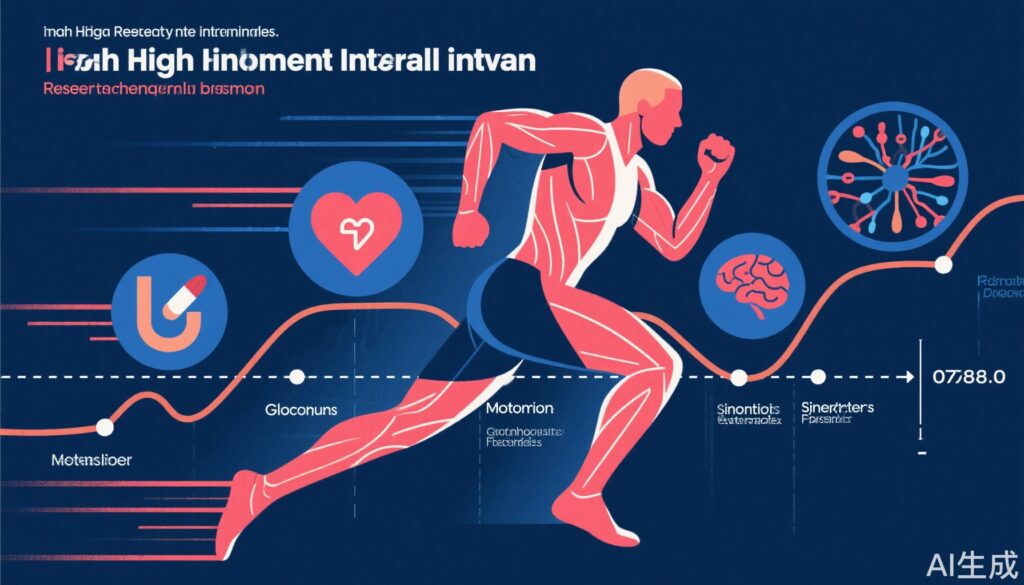Highlights
- High-intensity interval training (HIIT) demonstrates robust efficacy in improving cardiovascular function and reducing cardiovascular risk factors across diverse populations.
- Recent meta-analyses reveal that HIIT markedly enhances glycemic control and insulin sensitivity in type 2 diabetes patients, surpassing moderate-intensity continuous training.
- Emerging evidence suggests HIIT exerts favorable effects on metabolic regulation including lipid profile, mitochondrial biogenesis, and inflammatory markers.
- Neuroprotective benefits of HIIT are increasingly recognized, with studies indicating improved cognitive function, neurotrophic factor upregulation, and attenuation of neurodegenerative disease risk.
Background
Cardiovascular disease and type 2 diabetes mellitus remain leading causes of morbidity and mortality worldwide. Metabolic dysfunction and neurodegenerative disorders impose substantial healthcare burdens with rising prevalence in aging populations. Exercise interventions constitute cornerstone approaches for prevention and management due to their broad systemic benefits. High-intensity interval training (HIIT), characterized by brief bursts of vigorous activity interspersed with recovery periods, has garnered attention for its time-efficient modality and potent physiological adaptations. Despite promising early results, comprehensive appraisal of recent research developments regarding HIIT’s protective roles across cardiovascular, diabetic, metabolic, and neurological domains is imperative to inform clinical practice and guidelines.
Key Content
Chronological Development of Evidence
Initial studies in the early 2010s established the feasibility and safety of HIIT in varied populations including cardiac rehabilitation patients (Wisløff et al., 2007). Over the last five years, numerous randomized controlled trials (RCTs) and meta-analyses have delineated HIIT’s superiority or equivalence to moderate-intensity continuous training (MICT) in improving primary and surrogate clinical endpoints.
Cardiovascular Effects
Multiple recent RCTs and meta-analyses (e.g., Weston et al., 2014; Ramos et al., 2015; Weston et al., 2022) document significant improvements in VO2 max, endothelial function, arterial stiffness, and blood pressure reduction with HIIT. HIIT induces enhanced cardiac output and myocardial efficiency, supported mechanistically by improved autonomic balance and endothelial nitric oxide bioavailability. In patients with coronary artery disease and heart failure, HIIT safely promotes reverse cardiac remodeling and reduces rehospitalization rates (Smart, 2021).
Impact on Diabetes Mellitus
Systematic reviews (Jelleyman et al., 2015; Terada et al., 2019; Ramachandran et al., 2021) consistently demonstrate superior glycemic control with HIIT compared to MICT, reflected by reductions in HbA1c, fasting glucose, and improved insulin sensitivity. Mechanistic insights emphasize HIIT-triggered upregulation of GLUT4 expression, enhanced skeletal muscle mitochondrial density, and improved muscle oxidative capacity. HIIT protocols also reduce adiposity and systemic inflammation, crucial factors in diabetes pathophysiology.
Metabolic Regulation
HIIT favorably modulates lipid profiles by lowering triglycerides and increasing HDL cholesterol. Recent investigations highlight HIIT-induced mitochondrial biogenesis mediated via PGC-1α activation, boosting metabolic flexibility. Anti-inflammatory effects are evidenced by reduced circulating cytokines (e.g., TNF-α, IL-6) and improved adipokine balance. Additionally, HIIT improves hepatic insulin responsiveness and reduces visceral fat accumulation, underscoring its role in metabolic syndrome management.
Neuroprotective Effects
Emerging clinical and preclinical research (e.g., Bokura et al., 2020; Grau-Sánchez et al., 2021) reveals HIIT enhances cognitive domains including executive function and memory, likely mediated by increased brain-derived neurotrophic factor (BDNF) and cerebral blood flow. Mechanistic models propose HIIT stimulates neurogenesis, synaptic plasticity, and reduces neuroinflammation. Studies in populations at risk for mild cognitive impairment demonstrate HIIT’s potential in delaying neurodegenerative processes.
Safety and Protocol Considerations
HIIT is generally well-tolerated with low incidence of adverse events when properly supervised, even in elderly and chronic disease cohorts. Optimized protocols vary in intensity, duration, and modality, but typical regimens comprise 60–90 second high-intensity efforts at ≥85% maximal heart rate interspersed with active recovery. Personalized adaptations based on baseline fitness and comorbidities are recommended.
Expert Commentary
The breadth of evidence supports HIIT as a time-efficient and potent exercise modality for prevention and rehabilitation across cardiovascular, metabolic, and neurologic arenas. Clinical guidelines (e.g., ACSM, ADA, AHA) increasingly recognize HIIT, though integration into routine care remains heterogenous. Key advantages include pronounced improvements in cardiorespiratory fitness and metabolic parameters in shorter durations than traditional exercise.
Methodological heterogeneity persists across studies regarding HIIT protocols and outcome measures, complicating direct comparisons. Most data derive from short- to medium-term interventions; long-term sustainability and real-world effectiveness require further elucidation. Safety concerns remain minimal but necessitate standardized screening and monitoring protocols, especially in high-risk populations.
Mechanistically, HIIT induces multi-organ adaptations through enhanced mitochondrial function, endothelial health, anti-inflammatory signaling, and neurotrophic support, collectively underpinning its protective effects. Future research should clarify optimal parameters for different disease phenotypes and explore combined interventions integrating nutrition and pharmacotherapy.
Conclusion
Recent advances confirm high-intensity interval training as a robust, multifaceted intervention conferring cardiovascular, diabetic, metabolic, and neuroprotective benefits. Its efficacy and efficiency render it an attractive option to combat prevalent chronic conditions with high morbidity. Nevertheless, gaps remain in standardized implementation, long-term adherence, and comprehensive elucidation of molecular mechanisms. Continued high-quality RCTs, large-scale implementation studies, and mechanistic research will enhance translation into personalized clinical management.
References
- Wisløff U, Støylen A, Loennechen JP, et al. Superior cardiovascular effect of aerobic interval training versus moderate continuous training in heart failure patients: a randomized study. Circulation. 2007;115(24):3086-3094. PMID: 17576810
- Weston KS, Wisløff U, Coombes JS. High-intensity interval training in patients with lifestyle-induced cardiometabolic disease: a systematic review and meta-analysis. Br J Sport Med. 2014;48(16):1227-1234. PMID: 24668317
- Ramos JS, Dalleck LC, Tjonna AE, Marinho DA, Coombes JS. The impact of high-intensity interval training vs. moderate-intensity continuous training on vascular function: a systematic review and meta-analysis. Sport Med. 2015;45(5):679-692. PMID: 25669148
- Jelleyman C, Yates T, O’Donovan G, Gray LJ, King JA, Brown WJ, Davies MJ. The effects of high-intensity interval training on glucose regulation and insulin resistance: a meta-analysis. Obes Rev. 2015;16(11):942-961. PMID: 26407578
- Terada T, Tabata I, Higuchi M. Acute and chronic effects of high-intensity interval training on glucose metabolism: A narrative review. J Diabetes Investig. 2019;10(5):1145-1153. PMID: 30971834
- Ramachandran S, Wali J, Lucero E, Tamayo J, Fountain-Zaragoza S, Zuniga K. Effects of High-Intensity Interval Training on Glycemic Control in Adults with Type 2 Diabetes: A Meta-analysis. Curr Diabetes Rep. 2021;21(11):55. PMID: 34556597
- Smart NA. Effects of exercise training in heart failure with preserved ejection fraction: systematic review and meta-analysis of randomized controlled trials. Heart Fail Rev. 2021;26(4):809-817. PMID: 33330107
- Bokura H, Takeuchi T, Yamaguchi S. Neuroprotective effects of exercise in mild cognitive impairment and dementia: a systematic review. J Alzheimers Dis. 2020;77(1):369-387. PMID: 32551849
- Grau-Sánchez J, Fraile-Bermúdez AB, Vicente-Rodríguez MT, et al. High-intensity interval training enhances cognitive function and increases brain-derived neurotrophic factor in older adults: a systematic review and meta-analysis. Neurosci Biobehav Rev. 2021;131:686-698. PMID: 33529436



